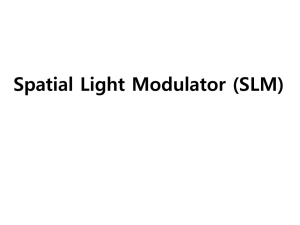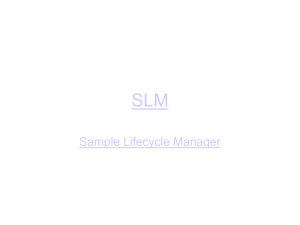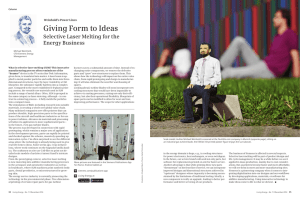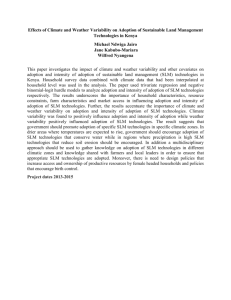Beam control in multiphoton microscopy using a MEMS spatial light
advertisement
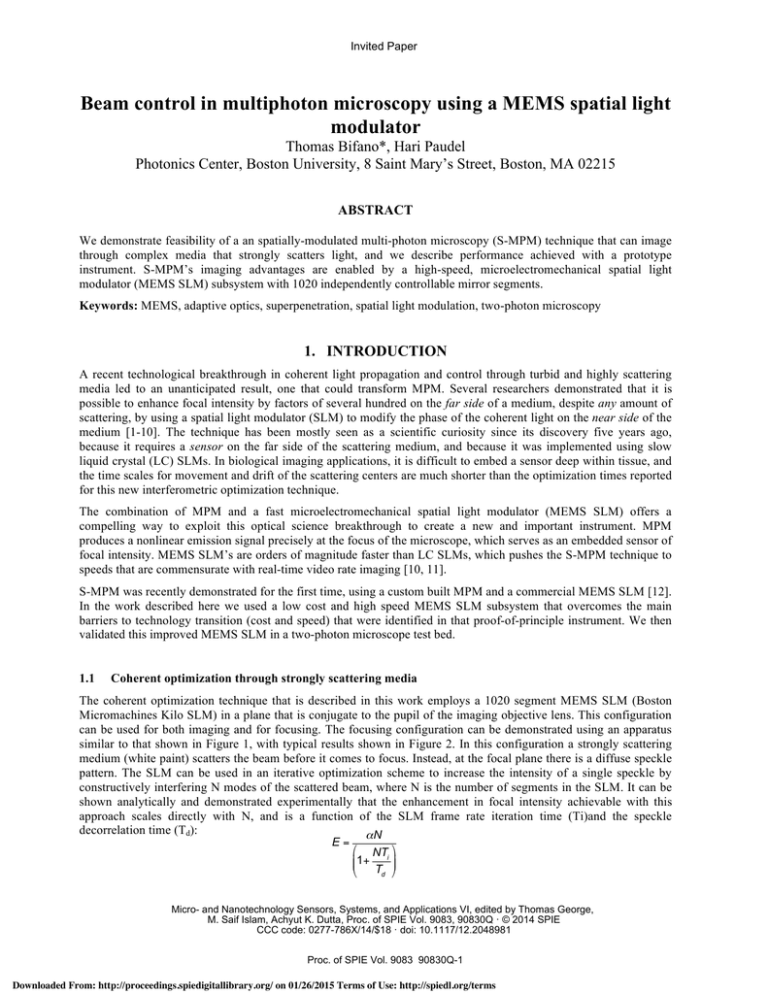
Invited Paper Beam control in multiphoton microscopy using a MEMS spatial light modulator Thomas Bifano*, Hari Paudel Photonics Center, Boston University, 8 Saint Mary’s Street, Boston, MA 02215 ABSTRACT We demonstrate feasibility of a an spatially-modulated multi-photon microscopy (S-MPM) technique that can image through complex media that strongly scatters light, and we describe performance achieved with a prototype instrument. S-MPM’s imaging advantages are enabled by a high-speed, microelectromechanical spatial light modulator (MEMS SLM) subsystem with 1020 independently controllable mirror segments. Keywords: MEMS, adaptive optics, superpenetration, spatial light modulation, two-photon microscopy 1. INTRODUCTION A recent technological breakthrough in coherent light propagation and control through turbid and highly scattering media led to an unanticipated result, one that could transform MPM. Several researchers demonstrated that it is possible to enhance focal intensity by factors of several hundred on the far side of a medium, despite any amount of scattering, by using a spatial light modulator (SLM) to modify the phase of the coherent light on the near side of the medium [1-10]. The technique has been mostly seen as a scientific curiosity since its discovery five years ago, because it requires a sensor on the far side of the scattering medium, and because it was implemented using slow liquid crystal (LC) SLMs. In biological imaging applications, it is difficult to embed a sensor deep within tissue, and the time scales for movement and drift of the scattering centers are much shorter than the optimization times reported for this new interferometric optimization technique. The combination of MPM and a fast microelectromechanical spatial light modulator (MEMS SLM) offers a compelling way to exploit this optical science breakthrough to create a new and important instrument. MPM produces a nonlinear emission signal precisely at the focus of the microscope, which serves as an embedded sensor of focal intensity. MEMS SLM’s are orders of magnitude faster than LC SLMs, which pushes the S-MPM technique to speeds that are commensurate with real-time video rate imaging [10, 11]. S-MPM was recently demonstrated for the first time, using a custom built MPM and a commercial MEMS SLM [12]. In the work described here we used a low cost and high speed MEMS SLM subsystem that overcomes the main barriers to technology transition (cost and speed) that were identified in that proof-of-principle instrument. We then validated this improved MEMS SLM in a two-photon microscope test bed. 1.1 Coherent optimization through strongly scattering media The coherent optimization technique that is described in this work employs a 1020 segment MEMS SLM (Boston Micromachines Kilo SLM) in a plane that is conjugate to the pupil of the imaging objective lens. This configuration can be used for both imaging and for focusing. The focusing configuration can be demonstrated using an apparatus similar to that shown in Figure 1, with typical results shown in Figure 2. In this configuration a strongly scattering medium (white paint) scatters the beam before it comes to focus. Instead, at the focal plane there is a diffuse speckle pattern. The SLM can be used in an iterative optimization scheme to increase the intensity of a single speckle by constructively interfering N modes of the scattered beam, where N is the number of segments in the SLM. It can be shown analytically and demonstrated experimentally that the enhancement in focal intensity achievable with this approach scales directly with N, and is a function of the SLM frame rate iteration time (Ti)and the speckle decorrelation time (Td): αN E= ! NT $ ##1+ i && Td % " Micro- and Nanotechnology Sensors, Systems, and Applications VI, edited by Thomas George, M. Saif Islam, Achyut K. Dutta, Proc. of SPIE Vol. 9083, 90830Q · © 2014 SPIE CCC code: 0277-786X/14/$18 · doi: 10.1117/12.2048981 Proc. of SPIE Vol. 9083 90830Q-1 Downloaded From: http://proceedings.spiedigitallibrary.org/ on 01/26/2015 Terms of Use: http://spiedl.org/terms Spatial filter Fold Laser, A =532nm mirror Fold Collimation mirror lens n 32x32 Segment MEMS SLM lOx 20x CMOS Camera 3 or PMT Tube lens Scattering medium: 12µm thick TiO2 paint Figure 1. Demonstration of focusing though strongly scattering media. Top: Optical schematic. Bottom: Image of system with superimposed indicator of beam path. SLM Phase Map (Waves) 500 0.4 5 400 ó 10 as u_ ai 300 15 E t os) a) Ç Ç W a 0.2 N 200 2 J 0 20 -0.2 25 100 -0.4 30 20 40 60 80 100 120 5 Time (Seconds) 10 15 20 25 30 SLM segment column Figure 2: Enhancement of focus through strongly scattering medium with transport mean free path equal to the sample thickness. A collimated continuous laser beam was modulated by a 1020 segment MEMS SLM upstream of the sample, and a camera recorded intensity downstream of the sample. The optimization scheme was based on modal control of the MEMS SLM using the intensity at the camera’s central pixel as feedback. The goal was to maximize that intensity. Left: Peak intensity enhancement with respect to the initial mean intensity, plotted as a function of time for the iterative optimization experiment. Right: Final state of the SLM, showing the spatially uncorrelated phase map that produces peak enhancement. Proc. of SPIE Vol. 9083 90830Q-2 Downloaded From: http://proceedings.spiedigitallibrary.org/ on 01/26/2015 Terms of Use: http://spiedl.org/terms 1.2 MEMS SLM subsystem for coherent control The MEMS SLM has a settling time of a few tens of microseconds, enabling rapid optimization (depending on the speed of the feedback sensor). The step response for a single segment is shown in Figure 3.! 1.2 0.8 Rise (120 -135V) Fall (135 -120V) 0.6 Single actuator response to 120 -135V (150n m step size) Square wave input 0.4 A4achment% posts% Mirror%segments% Electrosta0c%actuator% array% 02 Silicon%wafer% -020 10 20 30 40 50 60 70 80 90 100 110 120 130 140 150 time, µsec Figure 3: Step response of the MEMS SLM used in these experiments. Inset: Photograph of 1020 segment MEMS SLM, and cross sectional schematic showing basic MEMS SLM architecture. Because the optimization technique is interferometric, each mirror segment in the SLM need only provide a compensation range of one-half of the laser wavelength, (only half a wavelength is needed because reflection doubles the effect of physical stroke on spatially modulated wavelength). A specialized driver was developed by Boston Micromachines Corporation for this research. It was designed to provide an economical solution to interferometric control, with a range limited of 600 nanometers for each mirror segment and a bandwidth of 20kHz achieved using low-cost electronics. It is more than an order of magnitude faster than any other SLM that is commercially available, and is fast enough to enable dynamic control of aberrations in living tissue, where time constants measured in milliseconds are typical (Figure 4). The SLM and new driver were calibrated using a surface mapping interferometer (Zygo New View 6000) before integration with the S-MPM. Each of the 1020 active mirror segments in the SLM was actuated by input voltages ranging from 100-160V provided by the new driver. The corresponding segment displacements were measured and used to provide a calibration curve for each actuator. Through this technique, wavefront phase precision of better than 1nm over a range of 0-600nm was achieved for each segment. Following calibration, the SLM and the driver were integrated into the S-MPM microscope. 1.3 Multiphotn Imaging The S-MPM microscope uses the two-photon sensor signal as feedback to a coherent optimization controller. That is, focus intensity optimization corresponds directly to two-photon signal enhancement, which improves image quality. The S-MPM test bed allows computer controlled imaging over a 100 µm field of view (Figure 5). Proc. of SPIE Vol. 9083 90830Q-3 Downloaded From: http://proceedings.spiedigitallibrary.org/ on 01/26/2015 Terms of Use: http://spiedl.org/terms _ Figure 4: A custom-designed driver for interferomaetric control. The driver provides 20kHz frame rate update for the 1020-segment SLM. Beam dump Scanning mirror polarizer PMT 1 Dichroic 1 KiloSLM Sample PMT 2 Dichroic 2 Alf. ®_ , c.:: Camer a Figure 5. S-MPM test bed. The core of the test bed is comprised of a femtosecond laser illumination source, an SLM, scanning optics, a 16x water immersion microscope objective, and a three axis microscope stage. An example of optimization and imaging through a real and quite challenging biological scattering sample is depicted in Figure 6. The scattering sample was a portion of a mouse skull, measuring approximately 200µm thick. The skull, which had significant curvature, was immersed in water, and pressed against an underlying glass slide measuring 150µm thick. On the back side of the glass slide were clusters of 1µm diameter fluorescent polystyrene beads. For this experiment, the beads were imaged first without the skull in place, to provide a reference for what would be expected when imaging without the interference induced by scattering media. Then the skull was inserted in the imaging path, and a second image of the fluorescent bead layer was recorded. Next, the two-photon signal was optimized using feedback to the SLM, and then a final image of the fluorescent bead layer was recorded. The results demonstrate clearly that the proposed S-MPM technique surpasses the performance of conventional MPM in imaging applications characterized by strong scattering. The original image, without the mouse skull in the imaging path, shows clearly resolved bead clusters across the entire field of view of the microscope. With the skull in place, however, all capacity to resolve the bead clusters is lost. Optimization using the SLM restores near-perfect imaging, albeit over a reduced field of view. Proc. of SPIE Vol. 9083 90830Q-4 Downloaded From: http://proceedings.spiedigitallibrary.org/ on 01/26/2015 Terms of Use: http://spiedl.org/terms 19Max PMT =0.63259 23Max PMT =0.13404 17Max PMT =0.019266 0.6 0.5 0.4 0.3 Without skull, regular twophoton image 0.2 With skull, regular twophoton image With skull, Enhanced twophoton image 0.1 Figure 6. Two-photon image optimization through a strongly scattering biological medium: a section of mouse skull. Images correspond to 100µm field of view, and are of clusters of 1µm diameter fluorescent beads. Conventional MPM yields no discernable image of the bead clusters. S-MPM yields image quality in the central 20µm of the image that compares well with the image obtained without the mouse skull (All image intensity measurements are on the same color scale.) REFERENCES [1] Vellekoop IM and Aegerter CM, "Scattered light fluorescence microscopy: imaging through turbid layers," Opt. Lett., vol. 35, pp. 1245-1247, (2010). [2] Vellekoop IM and Mosk AP, "Phase control algorithms for focusing light through turbid media," Optics Communications, vol. 281, pp. 3071-3080, (2008). [3] Vellekoop IM and Mosk AP, "Focusing coherent light through opaque strongly scattering media," Opt. Lett., vol. 32, pp. 2309-2311, (2007). [4] Vellekoop IM, LagendijkA, and Mosk AP, "Exploiting disorder for perfect focusing," Nat Photon, vol. 4, pp. 320 - 322, (2010). [5] Popoff SM, Lerosey G, Carminati R, Fink M, Boccara AC, and Gigan S, "Measuring the Transmission Matrix in Optics: An Approach to the Study and Control of Light Propagation in Disordered Media," Physical Review Letters, vol. 104, p. 100601, (2010). [6] Popoff SM, Lerosey G, Fink M, Boccara AC, and Gigan S, "Image Transmission Through an Opaque Material," Nature Communications, vol. 1, (2010). [7] Small E, Katz O, and Silberberg Y, "Spatiotemporal focusing through a thin scattering layer," Opt. Express, vol. 20, pp. 5189-5195, (2012). [8] Katz O, Small E, and Silberberg Y, "Looking around corners and through thin turbid layers in real time with scattered incoherent light," Nat Photon, vol. 6, pp. 549-553, (2012). [9] Tripathi S, Paxman R, Bifano T, and Toussaint KC, "Vector transmission matrix for the polarization behavior of light propagation in highly scattering media," Opt. Express, vol. 20, pp. 16067-16076, (2012). [10] Conkey DB, Caravaca-Aguirre AM, and Piestun R, "High-speed scattering medium characterization with application to focusing light through turbid media," Opt. Express, vol. 20, pp. 1733-1740, (2012). [11] Stockbridge C, Lu Y, Moore J, Hoffman S, Paxman R, Toussaint K, and Bifano T, "Focusing through dynamic scattering media," Opt. Express, vol. 20, pp. 15086-15092, (2012). [12] Tang J, Germain RN, and Cui M, "Superpenetration optical microscopy by iterative multiphoton adaptive compensation technique," Proceedings of the National Academy of Sciences, vol. 109, pp. 8434-8439, May 29, 2012 (2012). Proc. of SPIE Vol. 9083 90830Q-5 Downloaded From: http://proceedings.spiedigitallibrary.org/ on 01/26/2015 Terms of Use: http://spiedl.org/terms 0.14 0.12 0.1 0.08 0.06 0.04 0.02

